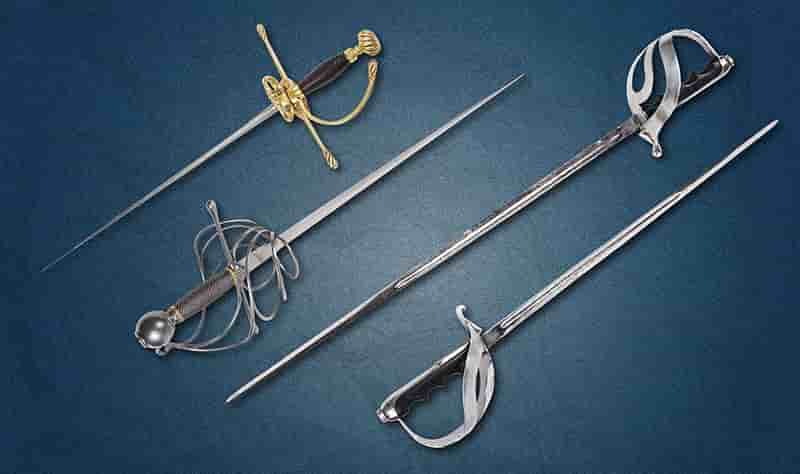When building a Bard: College of Swords, consider the following:
- Choose a race with high Dexterity and Charisma modifiers
- Build bard around fencing and social prowess
- Learn College of Swords benefits and Blade Flourish
- Choose bard spells that complement a swashbuckling fencer and aid the party
Bards of the College of Swords are swashbuckling entertainers with skillful combat maneuvers and mind-altering magic. Originally known as Blades, these bards use knife tricks, blade juggling and sword swallowing as a part of their performance. Naturally, these tricks translate to impressive sword fighting skills.
This character build makes for a romantic, charismatic adventurer and master fencer. Who better to play a character based on Zorro? Get that Antonio Banderas accent ready.
If you’d like a swashbuckling adventure for your dueling bard, check out my original pirate campaign, Dead Man’s Tale. Click here or below to learn more.
Choose a race with high Dexterity and Charisma modifiers
Dexterity and Charisma are the most important scores for bards in general. However, this fencer will need an edge in Dexterity, so that will be my highest score. With my character’s strong personality in mind, I’ll think of something fun.
Drow and tabaxi are my favorite picks for this sword fighter.
A drow fencer would have a +2 Dexterity and +1 Charisma bonus combination—exactly what I want for this build. I could play off elven nobility to portray him as a nobleman—something that may have a Zorro vibe. Normally, I’m not too impressed with the drow’s inherent dancing lights and faerie fire spells, but they could be used as fun performance tricks in this build.
Tabaxi offer a +2 Dexterity/+1 Charisma combination as well, with a few cat-like maneuverability options to boot. Speaking of boots, this character essentially looks like Puss ‘n Boots, which is, hands-down, going to be a good time. My fencer would also have the tabaxi’s Feline Agility, which doubles my movement speed in combat once a day.
Build bard around fencing and social prowess
When creating our bard at first level, we’ll need to build him for fencing—a studded leather armor/ rapier combination. Of course, I’ll be dagger-friendly as well, with a few on my hip for throwing. Plus, I’ll need my handy lute for bard spells. With the whole Antonio Banderas vibe, we could add elements of the Mariachi from Desperado.
For my beginning proficiencies, I’ll choose Acrobatics, Persuasion and Sleight of Hand. Eventually, I’ll lean on Acrobatics and Persuasion.
My swashbuckling bard will begin with essential bard abilities and tools, such as Bardic Inspiration, Jack of All Trades and Song of Rest.
Related Posts:
Guide to Building a Bladesinging Wizard: DnD 5e
| Guide to Building a Bard College of Valor: DnD 5e
|
Typically, Bardic Inspiration is used to aid allies’ attack rolls, skill checks and saving rolls. I receive an amount of inspiration dice (1d6) equal to my Charisma modifier and pass them out as needed. However, my sword abilities will also be linked to these inspiration dice, so I must plan accordingly. Either way, the option for this aid is available.
Jack of All Trades gives me an edge in any kind of skill check, adding half my proficiency bonus to the roll.
Song of Rest gives me an opportunity to play my instrument to heal the party during a short rest. Everyone in the party gains an extra 1d6 HP while I strum and sing.
Then, level 3 gives me Expertise, doubling my proficiency for 2 skills of my choice. For my performing swordsman, I’m going to have to choose Acrobatics and Persuasion as my expert skills. Now, I can cartwheel, flip and charm the pants out of NPCs.
Learn College of Swords benefits and Blade Flourish
Reaching level 3, I’ll gain several benefits that set me up as a College of Swords bard, including: Bonus Proficiencies, Fighting Style and Blade Flourish. These fundamental aspects will be the basis of how I play and deal with combat.
Firstly, I’ll gain Bonus Proficiencies with medium armor and a cutlass, which is all fine and dandy, but I’ll stick with my rapier. However, I will now be able to use my rapier as my spell focus.
Next, I’ll choose a martial Fighting Style to enhance my skill with the blade. My two choices are Two-Handed Fighting and Dueling. Though Two-Handed Fighting is tempting, adding my Dexterity modifier to my second attack hand, I’m sticking with Dueling for the +2 bonus to attack damage.
Blade Flourish offers me combat moves and bonus damage for 3 different scenarios. Each use costs a Bardic Inspiration die. My flourishes are:
- Defensive Flourish: Roll a Bardic Inspiration die (1d6) and add the number as extra damage to next attack. Then, add that number to AC until next turn.
- Slashing Flourish: Add Bardic Inspiration (1d6) roll as extra damage to target and damage to another touching target.
- Mobile Flourish: Deals extra damage equal to my Bardic Inspiration. Plus, push the target back 5 + 1d6 feet away. You can then use a bonus action to move next to the target.
Later levels will grant me an Extra Attack (level 6) and a Master Flourish (level 14). An Extra Attack will make me twice as lethal in melee combat. Master Flourish replaces my Bardic Inspiration die with a free 1d6—meaning I can spend more Bardic Inspiration rolls on helping my allies.
Choose bard spells that complement a swashbuckling fencer and aid the party
I’ll need to choose bardic spells for martial combat, aiding allies and keeping myself alive. Because I’ll use my Bardic Inspiration for sword moves early on, I’ll want to balance my spell choices with helpful selections. However, there’s always plenty of room to spice up my attacks.
Related Posts:
Top Swordsmen and Women in TV and Movies
| Guide to Building an Aarakocra Monk: DnD 5e
|
Cantrips
I’ll choose a collection of cantrips the aid my sword fighting, with an on-demand spell for damage.
- Mage Hand: An ethereal hand reaches up to 30 feet and can manipulate small items, locks and doors.
- Blade Ward: Gives me resistance to slashing, piercing and bludgeoning damage, keeping me alive at a melee range.
- Vicious Mockery: Deals 1d4 psychic damage on a failed Wisdom save. Plus, the creature has disadvantage on its next attack.
- Minor Illusion: Can be used to baffle my enemies’ senses momentarily—something I could use to creative effect.
1st-level spells
As I gain spell slots, I’ll want to add plenty of helpful choices along with my normal strategy.
- Cure Wounds: Heal anyone within touching distance for 1d8 + Charisma modifier. This is useful for myself or the tank I’ll be fighting beside.
- Detect Magic: Allows me pick up on magic auras from items, people, monsters and areas. I’ll be able to tell what school of magic it comes from as well. I think a cunning nobleman might have use of such skills to not be deceived.
- Thunderwave: Every creature within a 15-foot cube of me must make a Constitution save or be dealt 2d8 damage. Plus, they will be pushed 10 feet away from me.
- Bane: Choose 3 enemies within sight. Each must succeed on a Charisma saving throw. On fail, roll 1d4 and subtract from any attack or saving throw they make.
2nd-level spells
My choices for 2nd-level spells will lean toward game mechanics other than combat. I’ll still want to focus on helpful spells for my party.
- Invisibility: I turn invisible until I attack—a most Zorro-like spell for special circumstances.
- Zone of Truth: Creates a 15-foot sphere zone where creatures are forced to tell the truth. They must first fail a Charisma DC.
- Lesser Restoration: Cures one ailment or condition of a creature I touch: poisoned, blinded, deafened or paralyzed.
So, what do you think?
Does my fencing bard hold up? How would you personify this character build? Let me know in the comments below.






